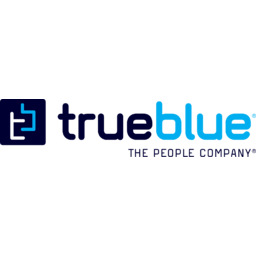
P/E ratio for TrueBlue (TBI)
P/E ratio as of April 2024 (TTM): -73.4
According to TrueBlue's latest financial reports and stock price the company's current price-to-earnings ratio (TTM) is -73.4419. At the end of 2022 the company had a P/E ratio of 10.3.
P/E ratio history for TrueBlue from 2001 to 2023
PE ratio at the end of each year
| Year | P/E ratio | Change |
|---|---|---|
| 2022 | 10.3 | -34.08% |
| 2021 | 15.6 | -417% |
| 2020 | -4.93 | -133.41% |
| 2019 | 14.8 | 9.46% |
| 2018 | 13.5 | -33.31% |
| 2017 | 20.2 | -130.35% |
| 2016 | -66.6 | -547.42% |
| 2015 | 14.9 | 7.08% |
| 2014 | 13.9 | -40.12% |
| 2013 | 23.2 | 25.34% |
| 2012 | 18.5 | -1.21% |
| 2011 | 18.8 | -52.04% |
| 2010 | 39.1 | -44.55% |
| 2009 | 70.5 | -173.69% |
| 2008 | -95.7 | -1064.93% |
| 2007 | 9.92 | -21% |
| 2006 | 12.6 | -24.02% |
| 2005 | 16.5 | -16.01% |
| 2004 | 19.7 | -35.42% |
| 2003 | 30.5 | 32.87% |
| 2002 | 22.9 | 3.2% |
| 2001 | 22.2 |
P/E ratio for similar companies or competitors
| Company | P/E ratio | P/E ratio differencediff. | Country |
|---|---|---|---|
 Robert Half RHI | 16.2 | -122.03% | 🇺🇸 USA |
 Kforce KFRC | 24.9 | -133.92% | 🇺🇸 USA |
 Kelly Services
KELYA | 595 | -910.67% | 🇺🇸 USA |
 Barrett Business Services BBSI | 17.6 | -123.97% | 🇺🇸 USA |
 ManpowerGroup MAN | 17.4 | -123.63% | 🇺🇸 USA |
 ASGN ASGN | 22.1 | -130.07% | 🇺🇸 USA |
How to read a P/E ratio?
The Price/Earnings ratio measures the relationship between a company's stock price and its earnings per share. A low but positive P/E ratio stands for a company that is generating high earnings compared to its current valuation and might be undervalued. A company with a high negative (near 0) P/E ratio stands for a company that is generating heavy losses compared to its current valuation.
Companies with a P/E ratio over 30 or a negative one are generaly seen as "growth stocks" meaning that investors typically expect the company to grow or to become profitable in the future.
Companies with a positive P/E ratio bellow 10 are generally seen as "value stocks" meaning that the company is already very profitable and unlikely to strong growth in the future.